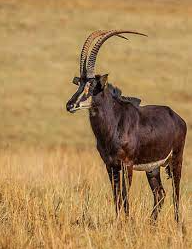The giant sable antelope, also known as the Palanca Negra, is Angola national animal. This striking antelope is a symbol of the country’s unique wildlife and cultural heritage. However, due to habitat loss and hunting, the giant sable antelope is now critically endangered. In this article, we will explore the physical characteristics, habitat, behavior, conservation status, and cultural significance of the giant sable antelope.
Physical Characteristics of Angola National Animal
The giant sable antelope is a large antelope species, with males weighing up to 320 kg and females weighing up to 200 kg. They have a dark brown coat with white markings on the face, neck, and legs, and impressive curved horns that can reach up to 1.2 meters in length. The horns of males are thicker and longer than those of females. These physical characteristics make the giant sable antelope a unique and impressive animal.
Habitat and Range
The giant sable antelope is found only in Angola, specifically in the forests of the Luando Reserve and Cangandala National Park. They prefer dense woodland and savannah habitats with access to water. These habitats are threatened by deforestation, human encroachment, and land conversion. The current range of the giant sable antelope is severely restricted due to habitat loss.
Behavior and Diet
Giant sable antelopes are social animals, living in groups of up to 30 individuals. They are primarily grazers, feeding on grasses and other vegetation, but they will also browse on leaves and bark when food is scarce. Males use their impressive horns to defend their territory and compete for mates during the breeding season.
Conservation Status of Angola National Animal
The giant sable antelope is currently listed as critically endangered by the International Union for Conservation of Nature (IUCN). The species has suffered significant declines due to habitat loss and hunting for meat and trophies. However, conservation efforts are underway to protect the remaining populations of giant sable antelope. These efforts include habitat restoration, anti-poaching patrols, and captive breeding programs.
Cultural Significance of Angola National Animal
The giant sable antelope has a deep cultural significance in Angola. The animal is featured on the country’s coat of arms and is seen as a symbol of strength and resilience. The Palanca Negra Gigante National Park was created to protect the giant sable antelope and promote ecotourism in Angola. The park also serves as a reminder of Angola’s natural heritage and the need to protect it for future generations.
Conclusion
The giant sable antelope is a unique and impressive animal that holds great cultural and ecological significance in Angola. However, the species is now critically endangered due to habitat loss and hunting. Conservation efforts are necessary to protect the remaining populations and promote their recovery. By working together, we can ensure that the giant sable antelope continues to thrive in Angola’s forests and savannahs.
References:
Angola National Agency for the Prohibition of Illegal Wildlife Trade. (2021). Giant Sable Antelope: Palanca Negra. Retrieved from https://anagenciamaianga.com/species/giant-sable-antelope-palanca-negra/
Bento, C., & Rodrigues, C. (2019). Giant sable antelope: a critical review on its biology, ecology and conservation status. Mammal Review, 49(3), 281-292. doi: 10.1111/mam
